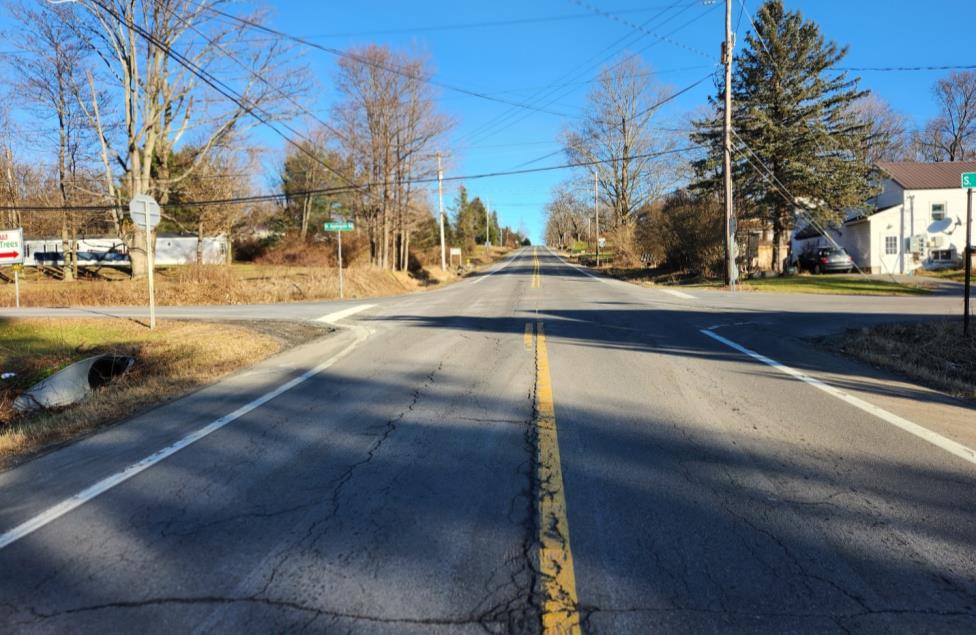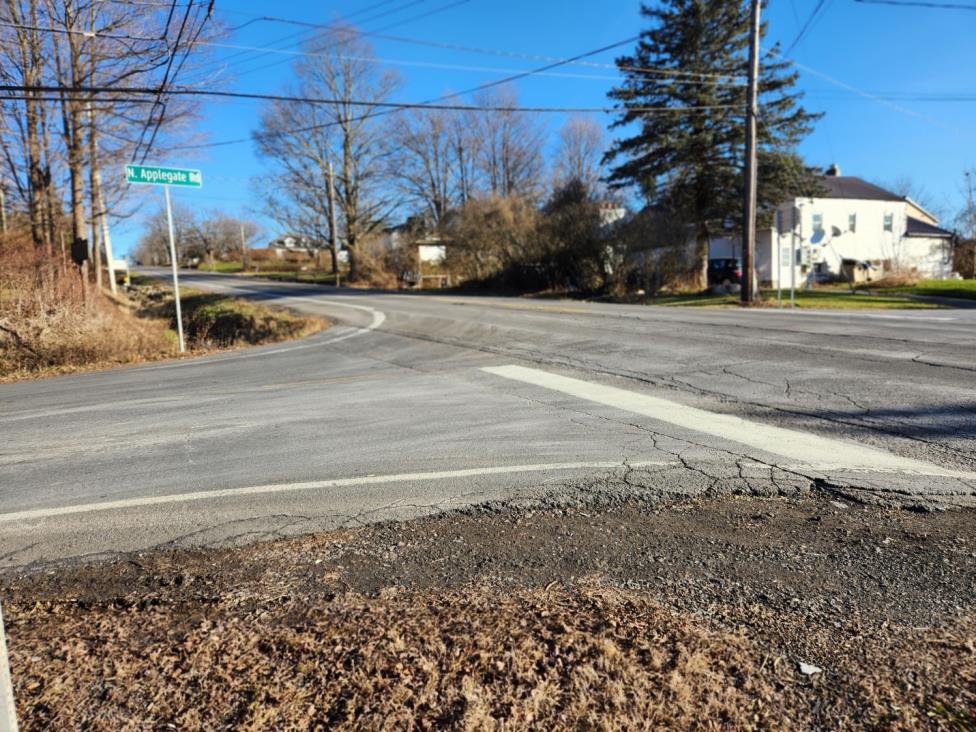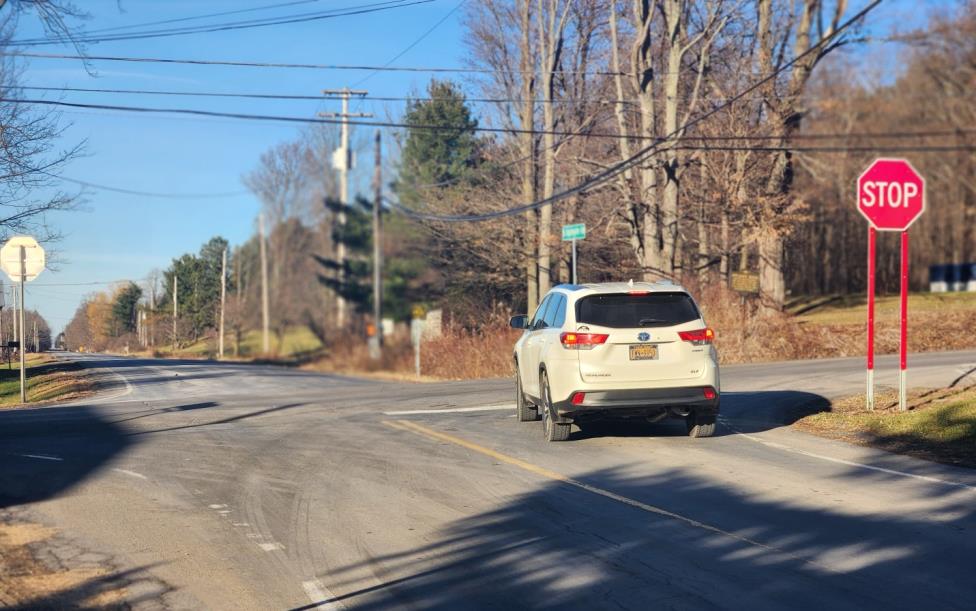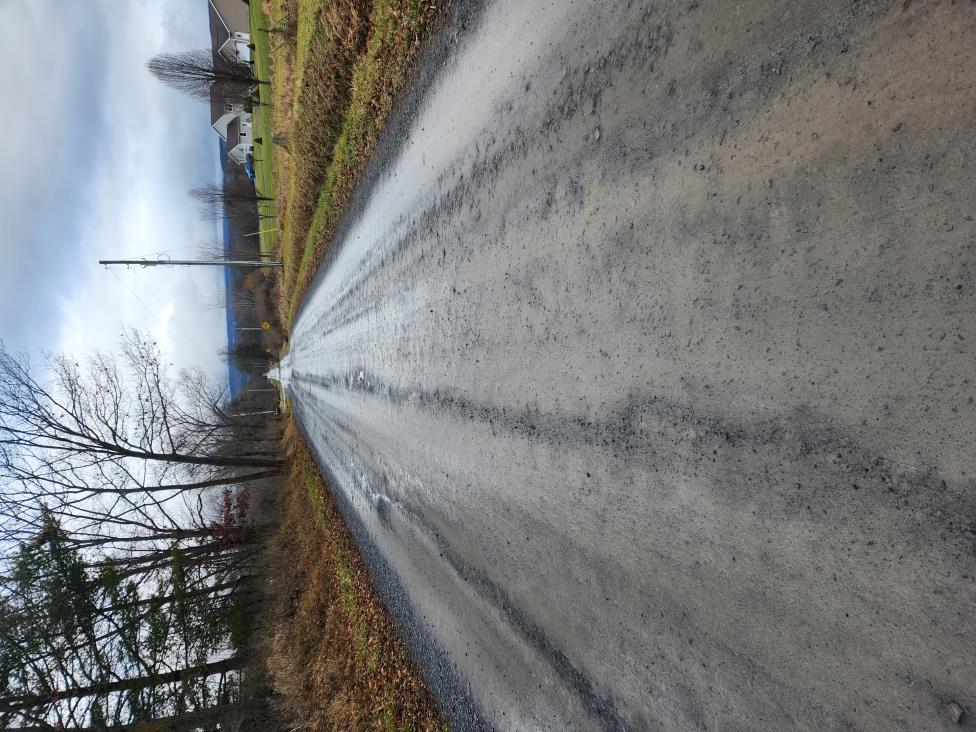Enfield Board seeks to bring safety to Applegate at 79
But reaping less success down south

by Robert Lynch; December 29, 2023
Many decades, long, long ago, my Dad worked at Morse Chain with a man we’ll call “Vince” (not his real name). Vince lived near Applegate Corners, the intersection of Applegate Road and Mecklenburg Road, State Route 79. Vince had a teenage son who loved go karts. One day Vince’s son drove his kart across Route 79 and was struck by an oncoming motorist. He died of his injuries. Vince’s son may not have been the only life lost at Applegate Corners over the years. But it’s the loss that’s left an indelible imprint on my mind.
On December 13th, following the second of two recent non-fatal, yet injury-producing accidents at Applegate Corners, the Enfield Town Board took action. By the unanimous vote of the three members then attending, the Board urged the New York State Department of Transportation (DOT) to study the crash-prone intersection and take steps to make the dangerous crossroads safer.
Under its Resolution, the Town Board requested Department staff to “consider any and all improvements that would enhance traffic safety at that intersection, improvements that may include, but are not necessarily limited to, upgraded signage, pavement modifications, and/or the installation of new traffic control devices, such as an overhead blinker.”
As protocol mandates, the Enfield request must first go through the Tompkins County’s Highway Department, whose Director, Jeffrey Smith, will refer it to New York State.
“It’s a terrible intersection if you’re on Applegate from either direction,” this writer, Councilperson Robert Lynch, said after introducing his Resolution at the December meeting. “It has to be made more obvious to people on Applegate (that), this is where you stop.”
What makes the Applegate/Route 79 intersection a worse hazard than than most is the restricted view that motorists on Applegate Road have to approaching Route 79 traffic from the east. Likewise, Route 79 westbound drivers may find they have too little time to react to vehicles crossing from Applegate Road.
“That hill has a fairly short sight distance,” Enfield Planning Board Chair Dan Walker remarked during the Town Board’s discussion. “And a car traveling at the rated speed coming down the hill, and somebody coming out of Applegate and looking up and then looking back again, and then not looking up again; and the amount of time it takes to look back and forth, somebody can be right on you.”
“You’ve got to look left and right and left and right before you cross, because the traffic on 79 is so fast, and there’s such a limited sight distance,” this Councilperson, Robert Lynch, concurred. “And I think at least the State should study it.”

Enfield Fire Chief Greg Stevenson, soon to become a Fire Commissioner, made his concern known about Applegate Corners at a Board of Fire Commissioners meeting November 6th. Stevenson called Route 79 and Applegate “our hot corner,” then telling Commissioners, “We have had significant accidents at that intersection recently this year.”
One multi-vehicle crash at the corner in late-August prompted Chief Stevenson to engage the Tompkins County Department of Emergency Response to encourage improved notification procedures to aid the Enfield Rescue Squad’s response to accidents of that type. But a second Applegate Corners two-car accident occurred in late-October and prompted Stevenson’s report to Fire Commissioners. In that second accident, the Fire Chief said, three ambulances were deployed to transport three patients, two of whom had suffered injuries serious enough to require hospitalization in Syracuse.
What State engineers may do to calm Route 79 traffic, remove visibility barriers, or alert Applegate Road drivers of their need to stop, will become known in time. But it’s unlikely that what we may get will be anything more than a yellow-and-red blinker. And if so, we may be lucky.
“Is there any reason we wouldn’t ask for a traffic light there?” Councilperson Jude Lemke questioned during the December 13th discussion. Lemke suggested that a three-way light that alternately stops traffic on both roads would be better.

“You can’t stop on that hill when it’s icy,” Supervisor Stephanie Redmond warned, the Supervisor pointing to the likely impracticality of halting Mecklenburg Road eastbound travel during inclement weather.
“The amount of traffic on Applegate Road, the volume, would not meet the requirements,” Walker interjected. Moreover, he said, “If we can’t get a three-color light at (Miller’s) Corners, we can’t get one at Applegate.”
The busier Miller’s Corners intersection, located one mile west of Applegate on Route 79, has had a blinker for decades. Transportation officials resist upgrading it to a traditional stoplight.
While safety improvements at Applegate Corners hold promise, a much different traffic problem frustrates Enfield’s leaders down at the Town’s southern border.
In response to a resident letter sent in September, the Enfield Town Board weeks later requested the State DOT to consent to lowering the speed limit on Van Ostrand Road, the gravel roadway that divides Enfield from Newfield on the town line. But now, the Department has refused to honor that request.
Jennifer Greenawalt, who resides on the Newfield side of Van Ostrand, described Van Ostrand’s state-defaulted 55 MPH speed limit as making her road “extremely unsafe.”
“The road is a dirt road that has many little inclines making visibility dangerous,” Greenawalt wrote Enfield in September, “not to mention the dust clouds that are kicked up due to the high rates of speed.”
“I have just like many others have, almost been hit numerous times,” Greenawalt warned the Enfield Board. “The most recent was yesterday morning,” she stated in her September letter. “Had (the other driver) not swerved he would have hit me head on,” she reported.

Yet logic and first-hand observations aside, the State Department of Transportation has proven to have a counter-intuitive way of evaluating such problems. Its reasoning has bedeviled Enfield’s leaders in the recent past. New York’s traffic planners notified Enfield in late-November that they reject categorically any immediate prospect of reducing speeds on Van Ostrand Road.
“NYSDOT follows the practice of not posting speed limits on unpaved roadways,” Scott Bates, the agency’s Regional Traffic Engineer, wrote the Town. “Studies have shown that lowered speed limits on gravel roads have negligible impact on improving safety and operations.”
Bates’ letter continued with even more questionable logic: “Additionally, the conditions of the (unpaved) road can deteriorate quicker than those of a paved road which may cause the posted speed limit to become inappropriate.”
The engineer said his agency would reconsider a reduced speed limit only after Van Ostrand Road is paved, an improvement that stands many years, if not decades, away.
“I’m really disappointed with how the State does stuff,” this Councilperson told the Town Board. Lynch suggested Enfield should lobby Albany lawmakers to grant it the same authority that cities already have to lower speed limits unilaterally, thereby circumventing the State Department of Transportation. By doing so, he said, “we don’t always have to go begging to New York State.”
“It doesn’t work that way, Bob,” Enfield Highway Superintendent Barry “Buddy” Rollins objected. “You’re going to have to have equipment like the State has; you’re going to have an investigation; you’re going to have a count of traffic,” Rollins maintained.
“If the Town has authority, we don’t necessarily have to do it with all that equipment and all that testing,” this Councilperson rebutted, Lynch noting that a recent change in state law now permits Ithaca and all other cities to cut their city speed limits to 25 miles per hour, a change Ithaca will soon implement.
“I’m sure the City of Ithaca didn’t do a whole lot of those studies to determine that Dey Street needs to be 25 miles per hour,” Lynch told Rollins. “But they’re going to do it anyway because the state law says they can do it.”
In other business at the Enfield Town Board’s December 13th meeting:
- In yet its third attempt—this one likely to succeed—the Town Board authorized purchase of a standby generator for the Highway Department. The new, 80 kilowatt generator Highway Superintendent Rollins located will be secured through state contract, thereby eliminating the need for bidding. But it also carries a nearly $68,000 price tag, a cost considerably higher than the $50,000 in American Rescue Plan funds the Town had set aside for the purchase. The Board solved the problem by pulling $18,000 from a Highway Equipment line upon Rollins’ recommendation. Rollins said generator delivery could take six months.
- The Town Board unanimously adopted a Councilperson Lynch-sponsored Resolution that strikes a middle-ground of sorts in the ongoing controversy over whether Tompkins County towns should contribute toward the Pilot Rapid Medical Response (PRMR) flycar rescue units that County Government will position in early 2024 to supplement the services of volunteer rescue squads. The Enfield Resolution recommends that the County, not the towns, bear the full cost of the PRMR in 2024—as now appears virtually assured—but that Enfield remains open to discussing cooperative support for future years. The adopted Resolution urged Tompkins County to negotiate with towns collectively, rather than one-by-one.
- And the Enfield Town Board marked the impending departure of James Ricks, the first African-American Town Board member in Enfield’s history. It did so by adopting a “Statement of Inclusion,” a Resolution submitted by Ricks and scripted with the assistance of the community group “Antiracists in Enfield.”
“[T]he Town of Enfield commits to promoting inclusivity in all aspects of our organization,” the Board’s unanimously-adopted Resolution states. The Statement of Inclusion commits the Town to ensure that Enfield Town policies and practices are inclusive and equitable. It also pledges to train staff and volunteers in the importance of inclusion; and to work toward “celebrating diversity and promoting cultural awareness through events, activities, and programs.”
“James joined the Board two, maybe three years ago; and I think it’s been a learning experience, it’s been a helpful experience,” this Councilperson remarked as he wished Ricks the best during opening comments at the December meeting. “We are a rainbow community, with people of all colors and all races and all backgrounds; and James, we appreciate your presence, we appreciate your service,” this Board member said.
In January, Melissa Millspaugh will replace James Ricks as Enfield Councilperson.
###

